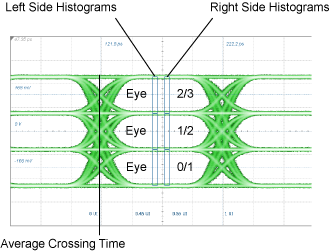PAM Partial EECQ
 The Partial EECQ (Electrical Eye Closure Quaternary) measurement is an electrical version of the TDECQ. Because EECQ is an electrical measurement, its value is double the TDECQ measurement as the math is 20 log10 instead of 10 log10.
The Partial EECQ (Electrical Eye Closure Quaternary) measurement is an electrical version of the TDECQ. Because EECQ is an electrical measurement, its value is double the TDECQ measurement as the math is 20 log10 instead of 10 log10.
The Partial EECQ measurement performs two measurements for each eye: Eye 0, Eye 1, and Eye 2. One of the two measurements is based on the left histogram and one measurement is based on the right histogram. This differs from the standard EECQ measurement where a single measurement is performed that includes the contribution of all three eyes. By comparing the individual EECQ contribution of each eye, the Partial EECQ measurements can provide additional insights into the causes of measurement problems.
The location of a measurement's histograms is annotated on the displayed waveform. Click on a measurement result to view the annotation. Like the standard EECQ measurement, these two vertical histograms are located at 0.45 UI and 0.55 UI from the waveform's average crossing time as is shown in the following figure. The signal source should be the output of the Reference Receiver waveform signal processing operator.

This measurement requires pattern lock.
To Perform a Partial EECQ Measurement
Use this procedure to make a compliant EECQ measurement.
- Connect the PAM4 electrical signal to an electrical input channel.
- In Eye/Mask Mode, click Measure > Waveform Signal Processing. In the Setup dialog, select the Signal Processing tab.
- Install the Reference Rx operator.
- Click on the operator to open the Reference Receiver Setup dialog. In the dialog's Select Equalizers tab, select the CEI-112G-Linear TP1a (53GBd) Preset. This preset places the reference point at the correct location, affects whether the measurement’s added noise is amplified by the noise gain of the equalizers.
- The output of the Reference Receiver operator is the signal on which the measurement should be performed.